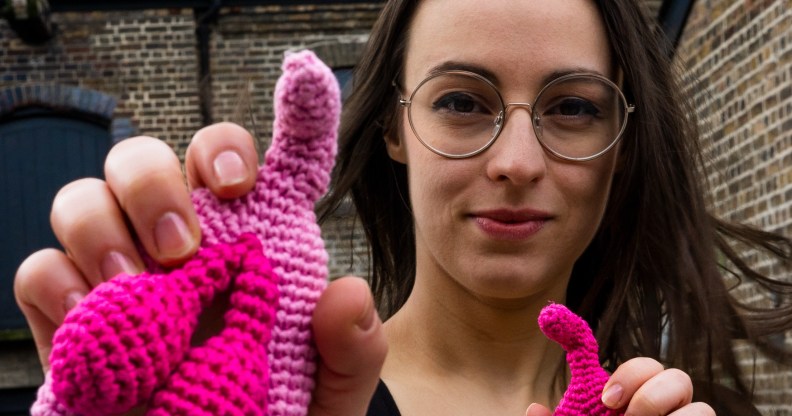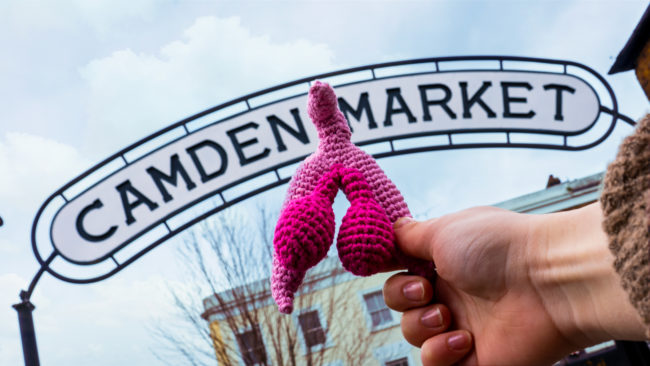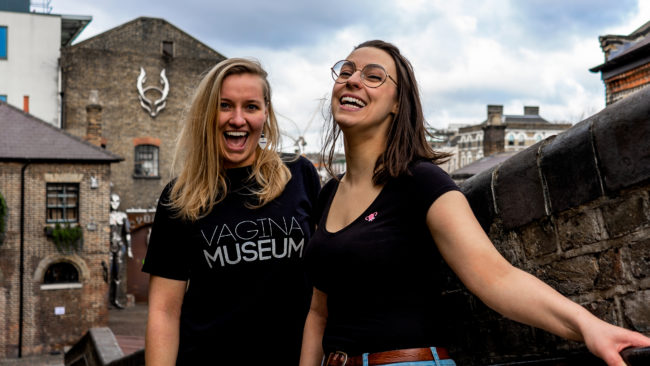The world’s first Vagina Museum plans to be LGBT-inclusive

The Vagina Museum founder and director Florence Schechter is keen on making the exhibitions inclusive of LGBT+ experiences. (Nicole Rixon)
Florence Schechter thought the museum world overlooked one important element of the human experience—vaginas.
The penis has its home at a museum in Iceland, but no such space is dedicated to scrutiny of the other vital organ in the process of giving life and pleasure.
“I thought that was kind of unfair,” Schechter tells PinkNews, explaining why, for the past two years, it’s been her mission to right that wrong.
After testing the waters of public interest in the project by running various events, the Vagina Museum has found a permanent home among the Stables Market in Camden, north London.

The Vagina Museum needs £300,000 to get a permanent home in Camden Market. (Nicole Rixon)
Only one issue stands in the way of Schechter’s dream—money. The Vagina Museum needs £300,000 to become a brick-and-mortar reality. A crowdfunding campaign has so far raised more than £20,000 from over 600 supporters.
“Camden Market are very supportive of the project and they have informally offered up a space, but we haven’t signed the lease yet because we need to raise money,” Schechter explains.
She adds: “We can’t raise money in kind of the traditional way. Museums usually will have some kind of anonymous wealthy benefactor and we don’t really have that. Or others get grant funding, but we’re quite a new organisation in the museum world, which moves very slowly. And we cannot go to a bank—there are all these rules about anything related to sex, or, or sexuality or anything like that. So we’re crowdfunding.”
How to make the Vagina Museum LGBT+ inclusive
Schechter, who holds a degree in chemistry and used to be a science communicator before becoming founder and director of the Vagina Museum, is keen on making the museum as inclusive a space as possible.
A bisexual woman herself, she ensured other members of the LGBT+ community are represented in the museum’s advisory board and trustee boards.
LGBT+ people will also be included as subjects of the museum’s exhibitions. Schechter says: “What happens a lot in museums and kind of in general, is that people forget that LGBT+ people are part of the human experience.”
“What I’d like people to take home from that is, vaginas are nothing to be ashamed of, being LGBT+ is nothing to be ashamed of.”
— Florence Schechter
The Vagina Museum instead promises to be explicit in acknowledging historical figures who people may not know were LGBT+, as well as including those that have been traditionally excluded from history and textbooks.
Schechter believes that the Vagina Museum can play a key role in breaking stereotypes and fighting stigma.
“What I’d like people to take home from that is, vaginas are nothing to be ashamed of, being LGBT+ is nothing to be ashamed of, it’s a totally normal thing that has been happening throughout history,” she says.
The awareness of history, she says, is particularly needed as the conversation around members of the LGBT+ community, such as transgender people, are looked at as if they are a new phenomenon.
“What I really hope that the museum will be able to do is [showing] actually, we’ve had transgender people all throughout history, but you don’t hear about them, because they’re not included in your textbook,” Schechter says.
To Schechter, it’s crucial that an inclusive look at the history of the vagina needs to acknowledge the historical exclusion and marginalisation of those who did not conform to the gender binary.
“Because of that, women specifically have been discriminated against because of their bodies, because of the vagina, and uteruses and, for example, the capacity to have babies. That doesn’t mean that other people haven’t been discriminated against. I feel like there’s room for both because it is nuanced,” she says.

The Vagina Museum founder Florence Schechter (R) and volunteer Jasmine Evans (L). (Nicole Rixon)
Unlike polarised views that pin women’s rights against transgender rights, the Vagina Museum will provide a space to create a mutually-supportive dialogue between those experiences.
Schechter says: “Women’s identities are not threatened by the existence of trans women. We can support each other and we can understand each other and we can understand what we’re going through.
“And the idea of the trans women, like, affect and threaten cis women’s existence, I think, is a very dangerous way of looking at the world. I don’t think that’s true at all and I think people are just trying to reinforce the status quo. True feminism should include supporting the trans community.”
Schechter has seen online criticism of her trans-inclusive stance, as well as the other kind of trolling such a project attracts from anonymous internet trolls—“but much smaller than you would think,” she adds.
No criticism can deter Schechter’s passion for the project, and her hope that the crowdfunding, which closes on April 18, will meet the target.
She says: “I think it would be really great to have a space in London which is openly trans-inclusive, because they are actually really hard to come by. Especially since so many LGBT+ venues have been closing around London, it would be so great to bring back a LGBT+ inclusive space.”

